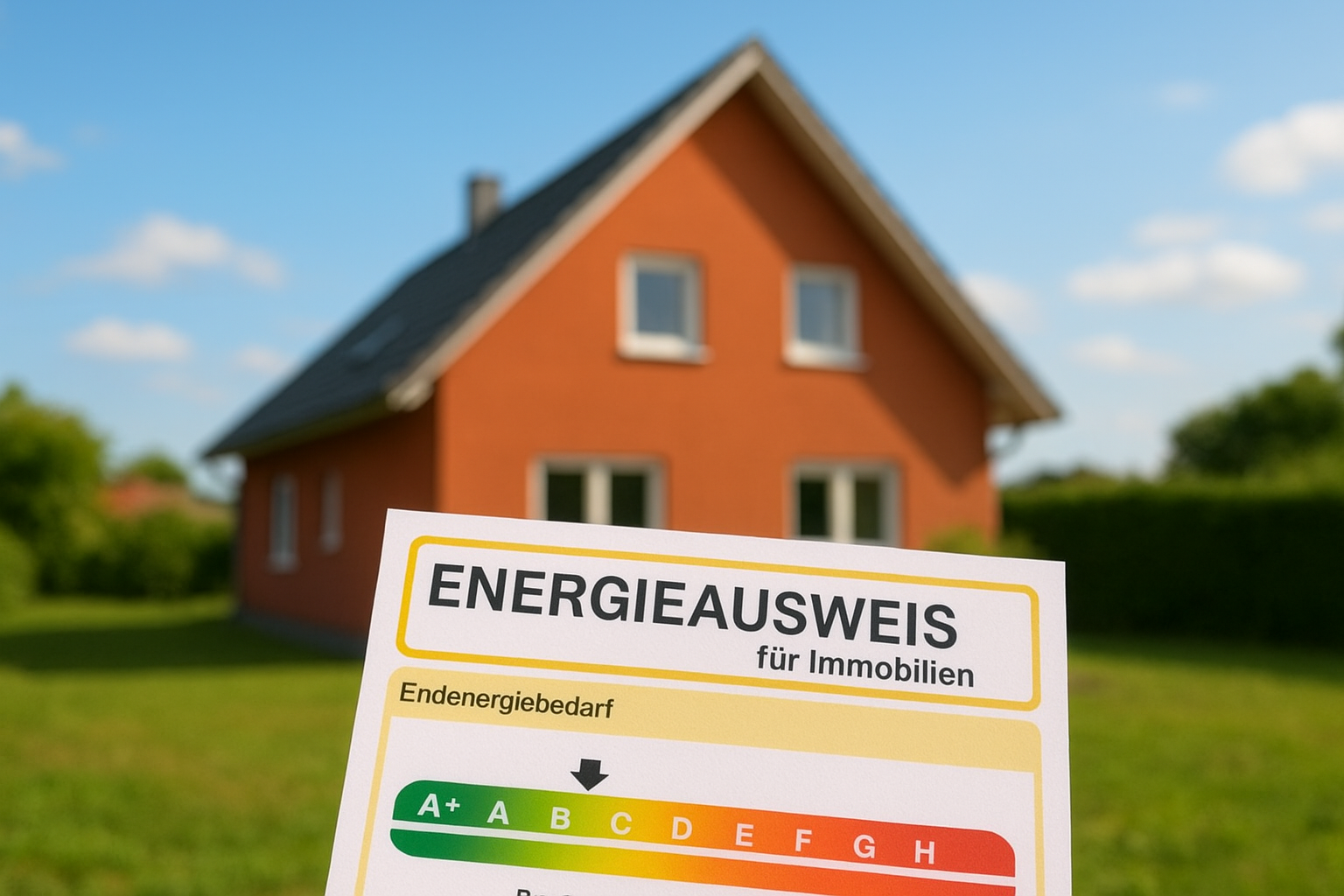The Energy Performance Certificate
From Green To Orange: What Does It Signify?

If you’ve been looking into real estate — whether as an investment or for your own use — and have browsed listings, you’ve probably come across the term Energieausweis (Energy Performance Certificate). If you’re not sure what it means or thought it wasn’t important, this guide is for you.
In recent years, energy efficiency requirements for buildings have become increasingly strict — driven by legal regulations. That’s where the Energieausweis comes in: a type of rating system that measures a building’s energy performance.
Below, we’ll explain exactly what an Energy Performance Certificate is, what types exist, what exceptions apply, how much it costs, and why it matters to you as a buyer or investor. And yes — we’ll even explain what it has to do with buying a fridge.
- Definition
- Consumption Vs. Demand Certificates
- When It's Mandatory
- Exceptions
- Application Process
- Costs
- Contents
- FAQ
What Is an Energy Performance Certificate?
Remember your last refrigerator purchase? You probably saw those green, yellow, and red labels showing how energy-efficient the appliance was. The same principle applies to a property’s Energy Performance Certificate.
The Energieausweis is an official document that provides information about a building’s energy consumption and efficiency. In other words, it gives an overview of the property’s energy condition.
In Germany, since 2007, all newly constructed or renovated buildings must have an Energy Performance Certificate in accordance with the Gebäudeenergiegesetz (GEG – Building Energy Act).
There are two types of certificates:
Energy Demand Certificate (Energiebedarfsausweis)
Energy Consumption Certificate (Energieverbrauchsausweis)
Both include details about a building’s energy demand or consumption, the type and efficiency of the heating system, insulation quality, and other energy-saving measures. Both are valid for ten years from the date of issue.
Differences Between the Consumption and Demand Certificates
So, what’s the difference between the two types? It’s actually quite simple — the name says it all.
The Energy Demand Certificate estimates how much energy a building is expected to use, while the Energy Consumption Certificate shows how much energy has actually been used. Because it’s based on real data, the consumption certificate generally provides a more accurate and realistic picture of a property’s energy use.
The values in the demand certificate are calculated based on heating requirements, hot water needs, and electricity use for lighting and appliances. These are determined through standardized calculations that take into account insulation, heating systems, and the building’s location. (Note: here, “location” refers to physical conditions like orientation and exposure — not the investment-related “location, location, location.”)
When Is an Energy Performance Certificate Mandatory?
According to the Building Energy Act, an Energieausweis is required when you construct, sell, or rent a building. It provides potential buyers or tenants with important information about energy efficiency and serves as a decision-making aid. It also helps identify areas where energy efficiency can be improved.
You must present the certificate to buyers or tenants before sale or rental, and provide a copy upon completion of the transaction.
In some cases, government agencies or energy suppliers may request to see the certificate — for example, when applying for subsidies for energy-efficient renovations or registering a new building.
Demand or Consumption Certificate: Which One Do You Need?
In Germany, all newly constructed or renovated buildings are required to have an Energy Performance Certificate. Whether an Energy Demand Certificate or an Energy Consumption Certificate is issued depends on the type of building and the scope of the renovation. In general, property sellers can often choose between the two. However, for new constructions, the Energy Demand Certificate is mandatory, while owners of existing buildings have more flexibility. Here’s an overview:
Date Construction | Number of Units | Complies with Thermal Insulation Regulations | Consumption Certificate | Demand Certificate |
|---|---|---|---|---|
before Nov. 1977 | ≤ 4 | yes | x | |
before Nov. 1977 | ≤ 4 | no | x | x |
after Nov. 1977 | ≤ 4 | n/a | x | x |
after Nov. 1977 | ≥ 5 | n/a | x | x |
The Energy Demand Certificate is issued for new buildings or for renovations of properties larger than 50 m².
The Energy Consumption Certificate, on the other hand, is issued for all buildings larger than 50 m² where the demand certificate is not mandatory — for example, for existing properties. It provides information about the building’s actual energy consumption as well as the type and efficiency of the heating system used.
Are There Any Exceptions?
As with most rules, there are exceptions. You don’t need an Energieausweis in the following cases:
The building is under historical preservation (listed status)
The property is being demolished or is set for demolition
The total usable space is under 50 m²
The building is owner-occupied
Applying for an Energy Performance Certificate: Who Issues It?
Section 88 of the Building Energy Act (GEG) defines who is authorized to issue an Energy Performance Certificate. Typically, energy consultants (Energieberater:innen) are qualified professionals with a relevant university degree in fields such as architecture, engineering, electrical engineering, or physics.
An energy consultant will conduct an on-site inspection of your property and then issue the Energy Performance Certificate.
There are several databases that list certified energy consultants. To find a suitable consultant, you can use the nationwide energy consultant directory or search the expert database of the German Energy Agency (DENA). DENA also offers an Energy Efficiency Expert List featuring professionals who provide advice on energy-efficient construction, renovations, modernization projects, and applications for government funding.
There are also qualified tradespeople who are authorized to issue an Energy Performance Certificate. It’s often a good idea to check with your local chimney sweep service, as they may offer this service as well. In addition to individual consultants, there are also various online providers that can issue an Energy Performance Certificate for your property.
Costs of an Energy Performance Certificate
The cost of an Energieausweis depends on several factors — mainly the property’s size and the type of certificate.
Average Costs for an Energy Consumption Certificate
Single- or two-family house: €50–100
Multi-family house (five or more units): €100–250
Average Costs for an Energy Demand Certificate
Single- or two-family house without on-site visit: €100–200
With on-site visit: €200–500
Multi-family house (five or more units) without visit: €300–500
With visit: starting at €300, plus €30–50 per unit
How to Read an Energy Performance Certificate: What’s Inside
The key figure for energy consumption is the energy consumption value, which is listed on the certificate. It is measured in kilowatt-hours, indicating how much energy is needed to heat one square meter of living space to 21°C.
In general, an energy performance certificate consists of several sections:
Page 1: This page provides details about the building, such as its address, type, and year of construction, as well as information about the issuer of the certificate. It also indicates whether it is a consumption-based or demand-based certificate.
Page 2: This page is only filled out for demand-based certificates. It lists all the key figures for energy demand according to the demand-based calculation method. You’ll also find a color-coded scale and a classification of the property into an energy efficiency class from A+ to H, allowing for easy comparison of energy efficiency across different properties.
Page 3: This page is only filled out for consumption-based certificates. It contains all the key figures for energy consumption according to the consumption-based calculation method.
Page 4: For demand-based certificates, this page provides tips for improving the energy efficiency of your property.
Page 5: This page offers explanations of key terms used throughout the certificate.
Energy Performance Certificate: What It Means for Your Property Investment
Even beyond legal requirements, we believe an energy performance certificate is very useful.
On one hand, paying attention to energy efficiency makes sense for environmental reasons and in the context of climate change. On the other hand, it is also highly relevant for your property purchase, whether you are buying a home for yourself or as an investment.
If you plan to live in the property, you naturally want to know what energy costs to expect. In times of rising energy prices, this becomes an especially important factor. The same applies if you buy a property to rent out. Finding tenants is much easier if your property is energy-efficient. Conversely, properties with particularly poor energy efficiency ratings may eventually require modernization or renovation, which can affect your investment returns.
Having an energy certificate also makes it much easier to sell your property, which can influence its value appreciation. Compared to these benefits, the cost of obtaining an energy certificate is relatively minor, wouldn’t you agree?








